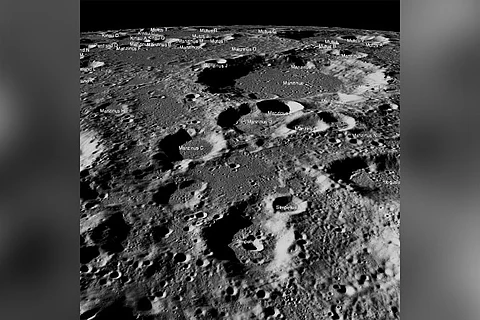

On Thursday, NASA released photos of the site where Chandrayaan-2’s lander Vikram was supposed to make a landing. However, the US space agency said that it was unable to determine the exact location of the Vikram, which unsuccessfully attempted a soft landing on the south side of the moon on September 7. Indian space agency ISRO lost contact with the lander minutes before the landing.
"Vikram had a hard landing and the precise location of the spacecraft in the lunar highlands has yet to be determined," NASA said.
The photos identify the site where Vikram was supposed to land as “a small patch of lunar highland smooth plains between Simpelius N and Manzinus C craters.”
“The scene (image) was captured from a Lunar Reconnaissance Orbiter Camera (LROC) Quickmap fly-around of the targeted landing site image width is about 150 kilometers across the center,” NASA added in a statement. “The site was located about 600 kilometers (370 miles) from the south pole in a relatively ancient terrain (70.8°S latitude, 23.5°E longitude),” it said.
A view looking down on the Vikram landing site (image acquired before the landing attempt), image width 87 kilometers (54 miles)
While neither ISRO nor NASA has been able to locate the crashed Vikram lander as of now, NASA did say that it was dusk when these images of the landing area were captured, and therefore it is possible that Vikram is concealed in the shadows.
“The lighting will be favourable when LRO (Lunar Reconnaissance Orbiter) passes over the site in October and once again attempts to locate and image the lander,” NASA said.
A wide view of a series of Lunar Reconnaisance Orbiter Camera's narrow angle camera images collected on Sept. 17 showing the area of the targeted Vikram landing site.
Chandrayaan-2 was India’s first attempt to at a soft landing on the lunar surface. The mission was a logical extension of the Chandrayaan-1 mission, which found traces of water on the moon’s exosphere; the successor attempted to find evidence of presence of water on the moon. If the moon has water, it is most likely on the south side, which does not get much sunlight.
On September 21, ISRO said that it would no longer be attempting to contact Vikram since the 14-day mission life of the lander expired that day. The space agency announced that the Chandrayaan-2 mission, despite Vikram having a crash landing, had achieved 98% of its objectives. The Chandrayaan-2 orbiter continues to be in the lunar orbit and has the life of one year.
"The orbiter was initially planned for a year, but with the optimum mission planning, there is every possibility that it will last for another seven and a half years, benefiting us for science experiments," ISRO Chief K Sivan had said.
Phots credits:NASA/Goddard/Arizona State University